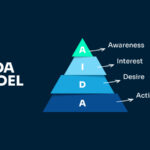Table of Contents
Are you looking for a proven method to boost your business’s success? Meet the AIDA marketing framework—one of the most powerful marketing models/ frameworks you can rely on. This marketing tool can help you attract customers, generate interest in your products or services, generate desire, and ultimately drive action.
In this blog, we’ll explore how you can use the AIDA model to supercharge your marketing efforts and achieve your business goals. Plus, we’ll dive into real-life examples to illustrate how successful companies have applied the AIDA framework to their advantage.
Whether you’re a small startup or a seasoned entrepreneur, mastering the AIDA model can make a significant difference in your business’s growth and success. So, let’s begin and unlock the secrets of the AIDA marketing framework!
What is the AIDA Marketing Framework?
AIDA stands for Attention, Interest, Desire, and Action.

It outlines the four distinct stages a potential customer goes through before making a purchase decision:
- Attention: In this stage, you grab the audience’s attention and pique their interest in your product or service.
- Interest: The next step is to generate more interest. You can do this by giving them relevant information about your product or service. Show how it can solve their problem.
- Desire: At this stage, you make your customer want to own or use your product by highlighting its advantages.
- Action: At this stage, you prompt the customer to take action. This could be to make a purchase, subscribe to a service, or contact your business for more information.
Why Use the AIDA Model?
The AIDA model offers several advantages for businesses:
- Structured approach: It provides a clear framework for crafting marketing messages that resonate with each stage of the customer journey.
- Improved marketing effectiveness: By understanding your audience’s needs and motivations at each stage, you can tailor your marketing efforts to be more persuasive and impactful.
- Measurable results: By tracking the performance of your marketing campaigns at each stage, you can identify areas for improvement and optimise your strategies for better results.
How to Apply the AIDA Model in Your Business
Applying the AIDA model in your business can be a game-changer when it comes to attracting customers and driving conversions. Here’s how you can leverage the AIDA model across various marketing channels to craft effective campaigns:
- Craft Attention-Grabbing Content: Use captivating headlines, vibrant visuals, and engaging storytelling to capture the audience’s attention across various channels such as social media, email marketing, and advertising campaigns.
- Highlight Unique Selling Points (USPs): Highlight Unique Selling Points (USPs). Clearly state the unique features and benefits of your product or service. This will spark interest and set you apart from competitors. Emphasise[2] [3] [4] what sets your offering apart. It could be superior quality, innovative technology, or exceptional customer service.
- Evoke Emotions and Aspirations: Tap into the emotions and aspirations of your target audience. This will cultivate a desire for your product or service. Use testimonials, success stories, case studies, and user-generated content. They create experiences that relate to potential customers.
- Provide Compelling Calls to Action: Include clear CTAs that prompt your audience to take the next step. This could be visiting your website, signing up for a free trial, or making a purchase. Use strong visuals, such as prominent buttons or arrows, to guide users towards your CTAs. Offer limited-time deals to encourage immediate action from potential customers.
Examples of AIDA Marketing in Action
Let’s illustrate the AIDA marketing framework with a couple of real-world examples:
- Apple
In its marketing campaigns for the iPhone, Apple excels at capturing attention with sleek visuals and minimalist design. The company generates interest by highlighting innovative features like Face ID and advanced camera abilities. Apple shows how the product fits into consumers’ lives. This cultivates desire and drives action. It does so by compelling CTAs to buy or pre-order the latest iPhone.
- Nike
Nike’s “Just Do It” campaign is effective. It captures attention with powerful storytelling and inspiring visuals. The visuals feature athletes overcoming challenges.The brand cultivates interest by emphasising the performance-enhancing features of its athletic apparel and footwear. By tapping into consumers’ aspirations for achievement and self-improvement, Nike builds desire and encourages action through compelling CTAs to shop for its products online or visit a retail store.
Conclusion
The AIDA marketing framework is a valuable guide for businesses. It helps them engage and convert potential customers.
Businesses can tailor their marketing strategies to captivate audiences. They can do this by understanding the four stages: Attention, Interest, Desire, and Action.
By applying the principles of the AIDA model, Businesses can add compelling content, persuasive messaging, and clear CTAs. This will let businesses optimise their marketing efforts and achieve greater success in today’s competitive landscape.






